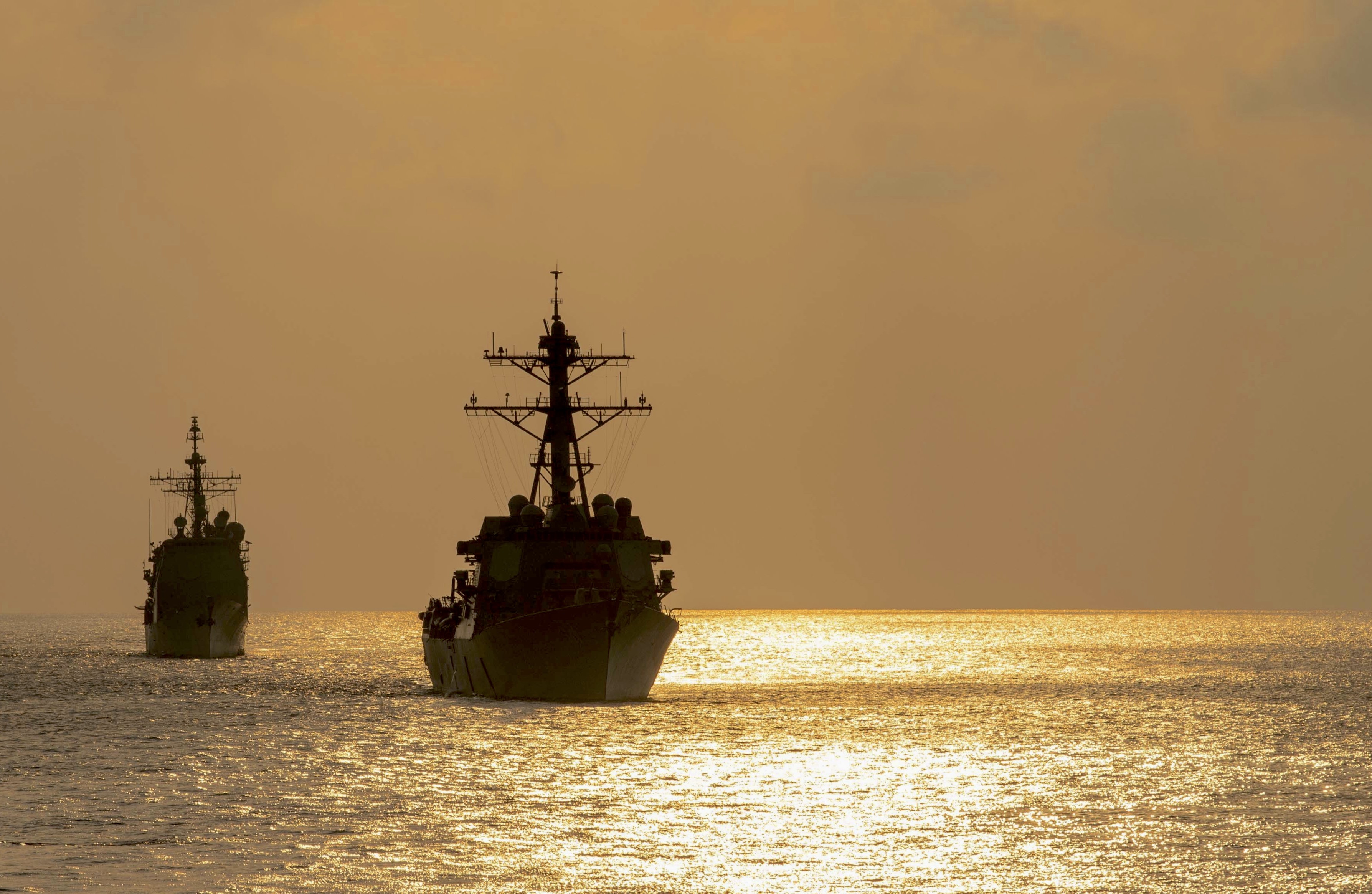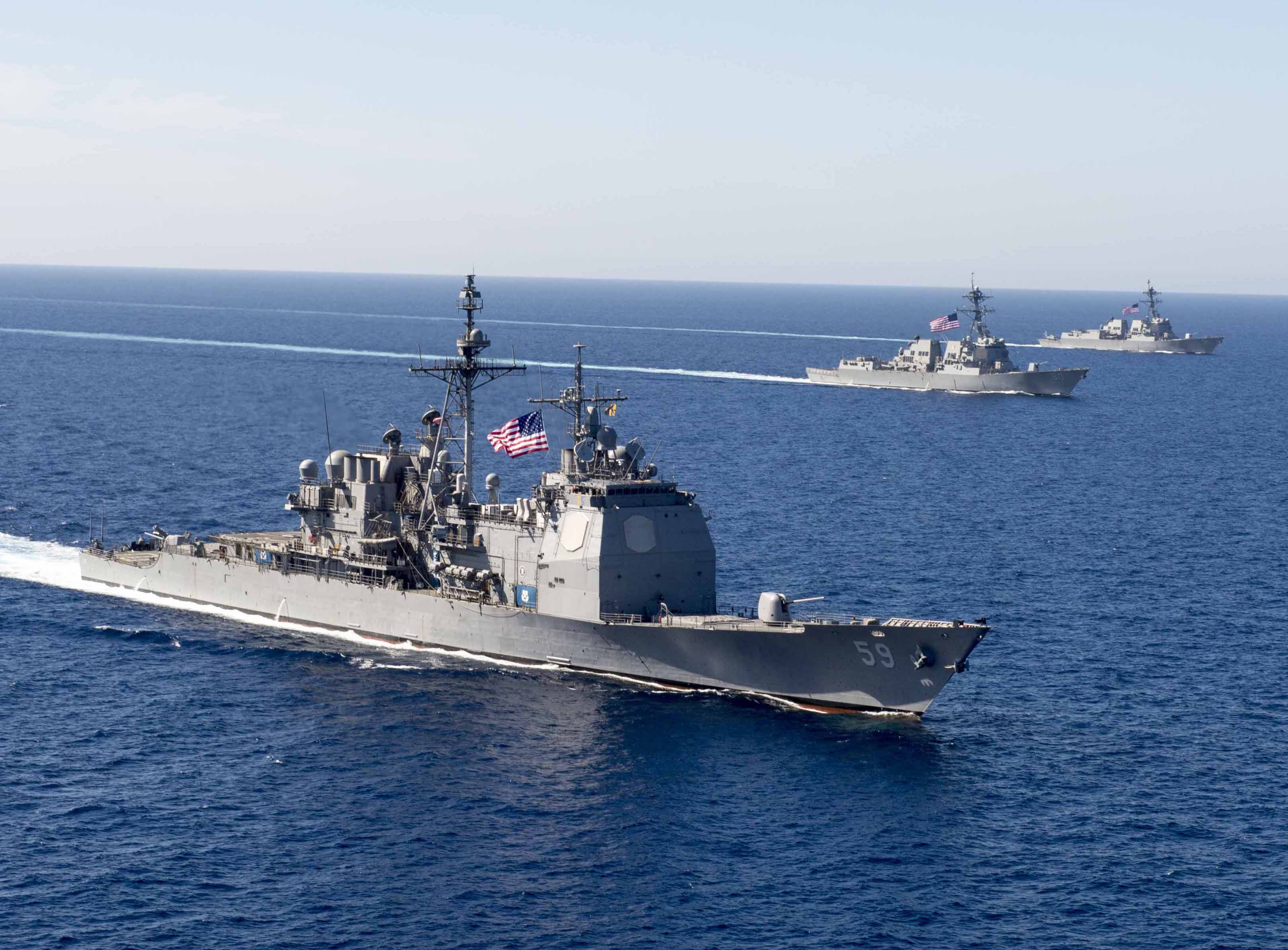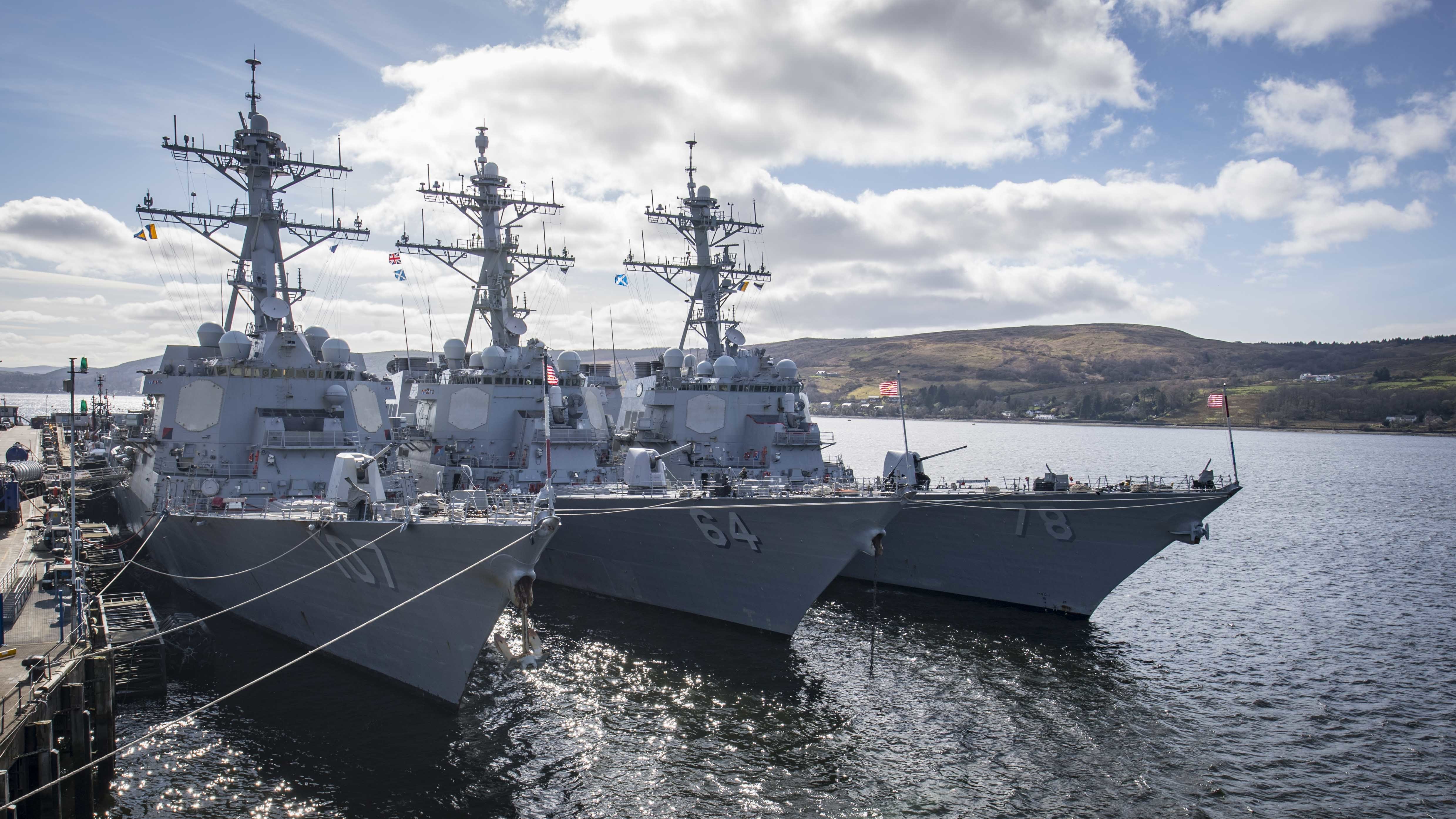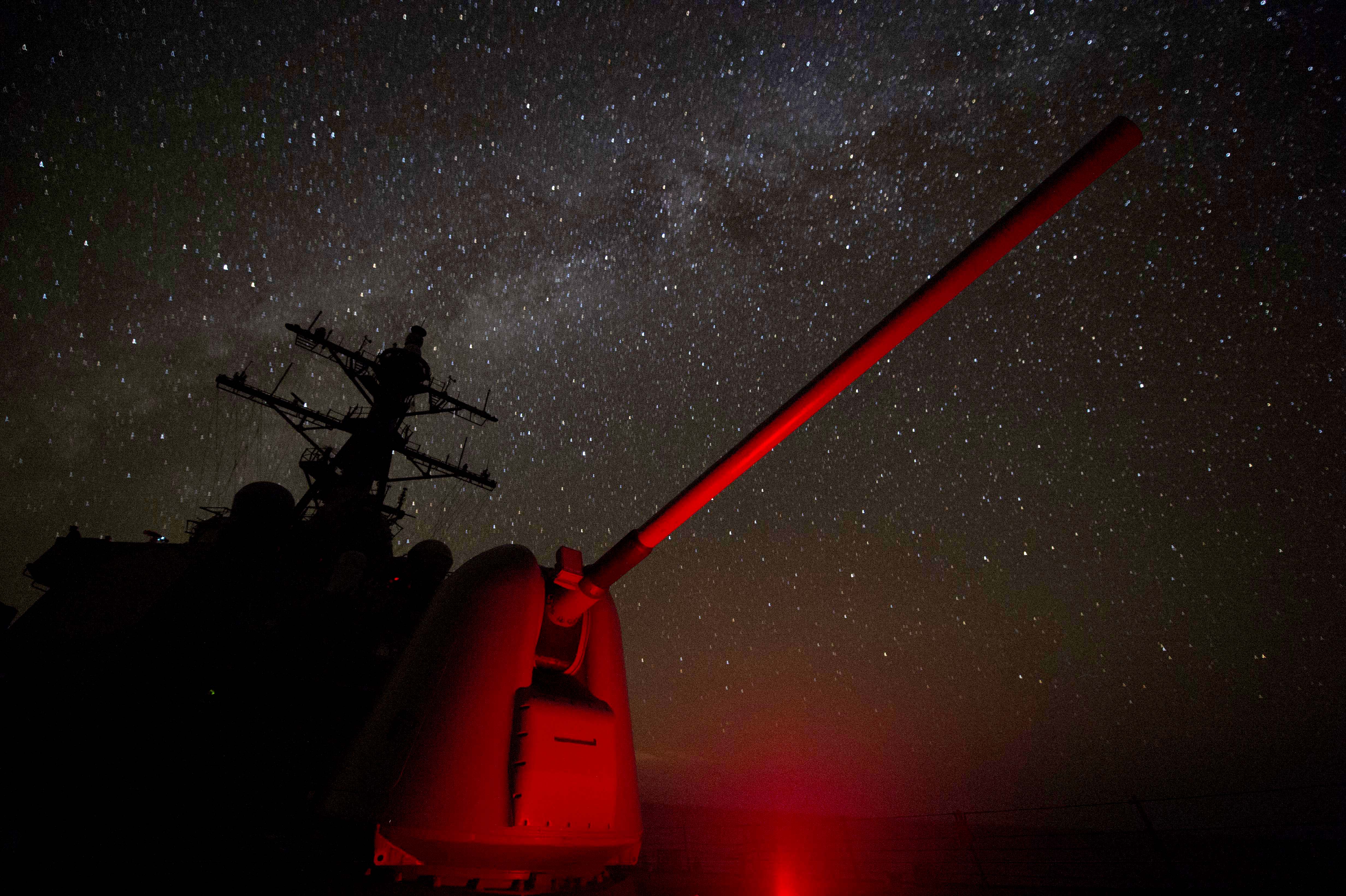
THE PENTAGON – Based on the Navy’s current vision of its future fleet, the service will be too top-heavy in the coming years, having more large combatants than it says it needs and not enough small combatants. But many attractive options exist today to add lethal capabilities to these large combatants and to extend their lives, and fewer options exist to speed the growth of the small combatant fleet, leaving the Navy pondering how best to invest in its surface force, the service’s top requirements officer told USNI News.
The ongoing discussions are informing the ongoing Force Structure Assessment effort, due out by the end of the calendar year, and point to the challenges of investing in today’s fleet while also keeping in mind the balanced fleet the sea service hopes to achieve down the road.
Conversations continue regarding the fate of the Navy’s oldest cruisers, how many existing destroyers should be backfit with the newest capabilities to boost them to a Flight III-like configuration, and whether the future Large Surface Combatant can be accelerated, Vice Adm. Bill Merz, the deputy chief of naval operations for warfare systems (OPNAV N9) told USNI News in an interview last week.
Cruisers

The fate of the Navy’s cruiser fleet has been in limbo for years, with each year’s budget proposal seemingly offering a new take on what to do with the 22 remaining Ticonderoga-class cruisers. The Navy previously tried to decommission its youngest cruisers early in lieu of putting them through a modernization period, but Congress forbid it. In the Fiscal Year 2019 budget, the Navy took a turn in the other direction, not only continuing a congressionally mandated modernization effort but also planning to extend the lives of the six oldest cruisers by five years each for a total cost of $2.4 billion.
“We’re sort of undoing that in 20,” Merz acknowledged, saying a primary driver of that life-extension request was keeping the ship count up to help reach the 355-ship goal.
Instead, the two oldest – USS Bunker Hill (CG-52) and USS Mobile Bay (CG-53), both of which were facing a FY 2020 decommissioning – were spared in the FY 2020 budget. The jury is still out on the next four, two of which may be decommissioned in FY 2021 and two in FY 2022.
“We are still enthusiastic about keeping those things around as long as we can,” Merz said, but with so many other options at hand for the size and strength of the surface fleet, “it may be best just to let those things retire because the maintenance does get more expensive and the operating does get more expensive” at their age.
“We’re really interested in those ships because they have been modernized to the latest fire control system already, that was done quite a while ago, so if we can fit – and it’s scalable; we may be able to fit five in, four in, just the two we kept in ’20. We don’t know, we’re going through that process now before the next budget. But obviously we are interested enough to defer that decision as long as we can because those are pretty valuable ships,” Merz explained.
The FY 2020 Long-Range Plan for Construction of Naval Vessels shows Bunker Hill and Mobile Bay being decommissioned in 2021 instead of 2020, but Merz said that wouldn’t be the case – for the sake of the sailors and their families, as well as the detailers who have to work out the manning of these ships, the Navy is trying to make decisions several years out regarding specific hulls instead of changing the plan last-minute.
“The ‘20 ships (Bunker Hill and Mobile Bay) we’re probably going to keep around just because, for a lot of reasons. We made that decision, we’re trying to not shift the decision within two years of the action, either keeping it online or inactivating it, and that’s purely for the families and everybody else who has to get orders and moves and everything else. So we’re really trying to settle down the [service life extension] decisions to make sure we don’t just keep jerking the crews and families around,” he said.
As for the other four – USS Antietam (CG-54) and USS Leyte Gulf (CG-55) facing a 2021 decommissioning and USS San Jacinto (CG-56) and USS Lake Champlain (CG-57) facing a 2022 decommissioning – Merz explained the competitive process they’d go through before the Navy can determine their fate.
“We’ll see how they compete. We’ve gone to a value-based competitive process when we build our Navy budget, and we’re starting to bring in algorithmic support to score them and grade them and it gives us a result. We have a Warfighting Council we put together to look at the results to make sure that we do the sniff test, the common sense test – if it comes out that, hey, the Navy’s actually more lethal without submarines, okay, well that’s not really a sensical answer. So far it hasn’t done anything like that, we have a lot of confidence in the programs we’re starting to run. And what that does is, it kind of helps us with about 80 percent, 90 percent of our budget, because it’s all pretty straightforward. And then that allows us to spend a lot more time on the really hard decisions so we can really expend a lot more intellectual bandwidth and make the right decisions on the really hard decisions,” Merz explained.
“And those cruisers were actually part of that really hard decision, because they score well lethality-wise: they’re fully modernized, lots of missile cells.”
The Navy needs to make up its mind whether those lethal cruisers compete well against the future potential of investments in things such as advanced weapons like hypersonics, new ships like the Large Surface Combatant, new unmanned systems like the Large Unmanned Surface Vehicle, and more.
Destroyers

FASLANE, Scotland (March 30, 2019) – The Arleigh Burke-class guided-missile destroyers USS Gravely (DDG 107), USS Carney (DDG 64), and USS Porter (DDG 78) are moored at HMNB Clyde in Faslane, Scotland, March 30, 2019. Carney, forward-deployed to Rota, Spain, is on its sixth patrol in the U.S. 6th Fleet area of operations in support of regional allies and partners as well as U.S. national security interests in Europe and Africa. (U.S. Navy photo by Mass Communication Specialist 1st Class Fred Gray IV/Released)
Complicating this decision is the other part of the current large combatant fleet, the Arleigh Burke-class cruisers. Merz announced last year that the Navy would administratively extend the life of all the destroyers to 45 years – meaning the ships would not need a maintenance period to do any work on them to support the life extension, but Navy plans would be changed to extend the planned 35- or 40-year lives to 45 years across the board.
Merz chalked that decision up to “just a result of the accumulating data – it turns out those ships were just really well built and they’ve done well in their maintenance periods. Typically when our maintenance periods have gone long, it’s not a reflection of that ship, it’s a reflection of some of the efficiency in our maintenance and capacity of our maintenance. The ships actually kind of did their part, they kind of came in with the stuff we knew we had to fix, we just weren’t really up to the task and we’re getting after that,” he said, acknowledging the backlog of ship repair work and delays in getting ships out on time.
“So all that accumulated data started telling a pretty good story about the DDGs, so this was literally an administrative extension based on past performance of the class. So there’s no additional money that needed to be laid in for any of these ships – as a matter of fact, the first of these ships wasn’t scheduled to go away until FY 26, so in FY 26 we’re going to have to continue funding the operations and maintenance of that ship on an annual basis depending on how many years we want to keep it around,” he continued, adding that it costs between $70 million and $100 million a year to operate a cruiser or destroyer.
With those ships sticking around longer, though, it begs the question of whether the Navy wants to enhance their capability in any way.
The first Flight III destroyer – with an advanced AN/SPY-6(v) Air and Missile Defense Radar (AMDR) – is under construction now and will join the fleet in 2023. Though the full Flight III capability cannot be backfit onto older DDGs due to the greater power and cooling requirement of the radar, a scaled-down version could be backfit.
“How much of this capability can we backfit onto the Fight IIs now that we’re extending them? There are just a spectrum of scalable options, and we’re going to take advantage of as many as we can. It’s really going to come down to, how many of what types of capability do you want in each battle group, and that will probably set the baseline for how many we modernize,” Merz explained.
“Very unlikely we’re going to do that to all of them, we just don’t need to – a couple Flight IIs are a pretty hefty capability versus the modernization effort to make one of them more like a Flight III. So that’s ongoing work. We are just getting the pricing from the vendors on what it takes to upgrade Flight IIs, so that’s going to be a pretty healthy discussion.”
Merz said the Navy is completely committed to the Flight III design and AMDR, and between the Flight IIIs under construction and on contract and the potential to add Flight III-like capabilities to older Flight II hulls, “that’s going to have a big impact on how many (cruisers) we keep around. We have a lot of options.”
Future Surface Combatants

Also swirling around in these discussions are the Large Surface Combatant – currently set to begin in 2025, but potentially being accelerated a year or two if industry can support a faster timeline – and the upcoming construction and fielding of the frigate, which Merz said is surpassing expectations already in terms of the lethality that industry can put into a small combatant.
“The FSA may actually help us on, how many (destroyers) do we really need to modernize, because I think the FSA is going to give a lot of credit to the frigate – if I had a crystal ball and had to predict what the FSA was going to do, it’s going to probably recommend more small surface combatants, meaning the frigate … and then how much fewer large surface combatants can we mix?” Merz said.
An issue the Navy has to work through is balancing a need to have enough ships and be capable enough today, while also making decisions that will help the Navy get out of the top-heavy surface fleet and into a better balance as soon as is feasible.
“You may see the evolution over time where frigates start replacing destroyers, the Large Surface Combatant starts replacing destroyers, and in the end, as the destroyers blend away you’re going to get this healthier mix of small and large surface combatants,” he said – though the new FSA may shed more light on what that balance will look like and when it could be achieved.





